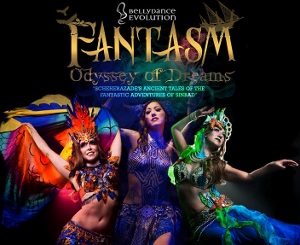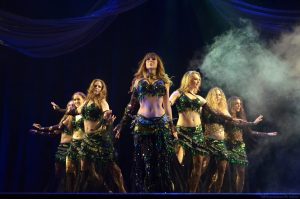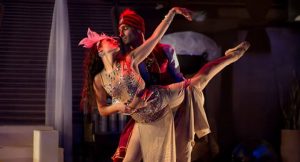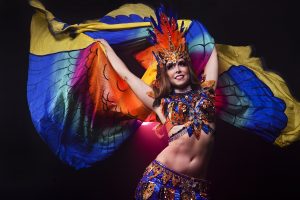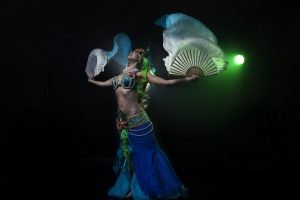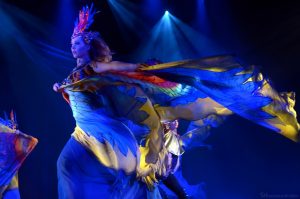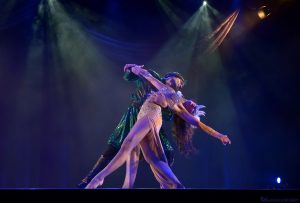FANTASM’S FANTASTIC FORAY INTO BELLYDANCING
Bellydance Evolution’s Fantasm’”Odyssey of Dreams is a well-interpreted and abridged re-telling of One Thousand and One Nights, the Arabian tale that combines the legend of Queen Scheherazade with her stories about fictional celebrated sailor Sinbad. Portrayed by a multi-cultural cast assembled by choreographer Jillina Carlano, the ensemble successfully brings the story-telling aspects of bellydancing to this updated twist. Overall, this Los Angeles debut provides western audiences with a wonderful introduction to Middle Eastern dance and folklore that does not deviate too far from the genre’s performance art roots.
Since Fantasm focuses on Scheherazade’s story, viewers get the Arabic mythological basics, which—through Carlano’s inclusion of the Icons of Creation (Sharon Kihara), Love (Heather Aued) and Wisdom (Carlano), from whom the queen seeks advice—will appear new even for those familiar with the tale (Scheherazade is played by Margarita Kamjaka). Although their roles are invented for the piece, the symbolism attributed to each character adds to Scheherazade’s personal narrative by emphasizing the fairytale concept behind the conception of both the queen and King Shahryar (Ruslan Kurlovic), to whom she tells her stories.
The newly re-vamped Ford Amphitheatre has gorgeous stone steps all around, and they were used to great advantage; the old-worldliness created by this venue made it difficult to imagine the performance taking place in a standard theater. Elaborate props and costumes designed by multiple artists add an additional visual dimension. Because of quick-change scenes between the royals and Sinbad’s adventures, the transitions depend heavily on dress, not just dancing, to help audiences distinguish between macabre characters such as the Icon of Creation—who sports long, blue twisted horns—and Queen of Snakes (also played by Kihara) with her Cleopatra-like headpiece.
Similarly, props play a big role in constructing new scenes. Underwater and sea-related sequences include the dancers wearing fin-like headpieces that flutter as they make waves with their arms and torsos, weaving into view with cool-tone lighting (designed by Ben Spronk) and the flapping of long, blue sheet-like tarps and scarves by various members of the ensemble. Similarly, Sinbad’s boat is symbolized by a constantly rolling light brown, rectangular fabric which the group keeps on their side, covering their bodies from the waist down to simulate their floating in his ship.
Former Cirque du Soleil performer, Kapua, is brilliant as Sinbad the Sailor, whose boredom and seafaring adventures both introduce us to further aspects of Arabic lore and whose restless ambitions mirror the king’s need to consistently marry a new wife every night (before Scheherazade comes along to entertain him with her fables). Traditionally, Sinbad is a more ruthless survivor who adopts a whatever-it-takes approach to make it out of each predicament he finds himself in. However, Carlano’s version ties in a romantic edge to his personality, which Kapua portrays well with facial expressions of anguish at losing a newly married wife in one exploit, alongside his quick and clever athletic gestures. His rendition of Sinbad is polished to be a little more endearing and heroic (similar to the altering of western tales for children’s first encounter with the Brothers Grimm).
Kapua’s high-energy squats and jumping encapsulate the essence of Sinbad’”a restless trouble-maker whose sharpness and quick moves allow him to escape whatever mess he finds himself in. One such situation includes fighting off darkly dressed snakes from preying on the brightly lit and valuable eggs he collects from bird creatures (called “rocs” in Arabic folklore). The rocs are easily distinguished by their colorful feathers that glide in a roc/snake dance-confrontation. Cast members playing snakes are obvious because of the way in which they lead with their right arms, moving them in curved “S”-shapes which they follow with their hips.
Fantasm’s incorporation of loud drumming with bouts of live performances—featuring musicians Donovan Lerman and Ozzy Ashkenazi—adds an element of authenticity to Carlano’s work. Especially when spotlighting her and Kapua as they pop their bodies comically in rhythm with every fast beat. Live music elicits an earthiness to each movement that is essential for bellydancing. However, Carlano’s solos, though wonderful, are a bit long and give off the feeling that she needs to remind viewers of her status as artistic director.
Otherwise, her inclusion of these “breaks” within the scope of Fantasm are reminiscent of bellydancing shows one might go see in Middle Eastern venues. We also see the Lebanese dabke, an ancient line dance executed in one of Sinbad’s adapted adventures to signify celebration, and the modern Egyptian sha’abi, which is shown during the snakes’ appearance.
The production is an exciting venture with both contemporary and traditional components that anyone can enjoy, even or especially for those who grew up watching and hearing about Sinbad and Scheherazade.
photos by K Winkler
Bellydance Evolution: Fantasm’”Odyssey of Dreams
The Ford Theatres
John Anson Ford Amphitheatre
2580 Cahuenga Blvd, E in Hollywood
played July 21, 2017
for more shows, call 323.461.3673 or visit Ford Theatres
for more info, visit Bellydance Evolution
